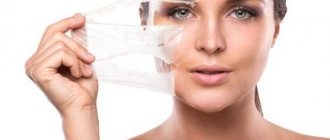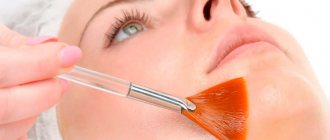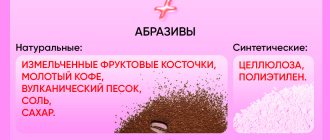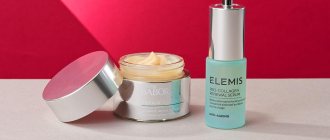Superficial and medium chemical peels
Principles of action and types of chemical peelings - chemical peeling is based on the action of chemical agents (most often acids) and allows you to remove dead skin layers at the same chemical peeling depth, while simultaneously stimulating the regeneration of young cells.
Today, this method of aesthetic medicine still remains one of the most popular. The popularity of chemical peeling is due to its high efficiency, combined with a relatively low cost. Unlike their physical and mechanical counterparts, chemical peels are simple to perform and do not require expensive equipment. If they are performed according to indications and, most importantly, by a cosmetologist, their results are truly impressive! Principles of action and types of chemical peels remove dead skin layers by stimulating the regeneration of young cells.
Depending on the depth of skin damage, all chemical peels are divided into superficial (glycolic peeling, milk peeling, retinoic peeling, pyruvant peeling) and medium. Superficial ones have an effect within the stratum corneum of the skin, middle ones penetrate the skin to the entire depth of the epidermis without damaging the basement membrane, and deep ones affect the basement membrane - partially or completely. It should be noted that deep chemical peeling is a type of surgical operation. And it is almost never used in the practice of a dermatocosmetologist of aesthetic medicine.
Any chemical peel is essentially a chemical burn to the skin. Correct pre-peeling preparation and the use of modern peeling compounds can minimize the risk of complications. Strict control of the depth of damage and creation of optimal conditions for subsequent skin rehabilitation. The Medic Control Peel line includes not only preparations for professional peeling. But also a full range of additional products for pre-peeling preparation and home skin care during the rehabilitation period. And also to maintain treatment results. With such a reliable arsenal at your disposal, you can perform chemical peels in summer and winter.
Indications for use:
- skin aging (wrinkles, decreased turgor, sagging, microrelief disturbances);
- hyperpigmentation of various etiologies;
- problematic skin (acne, rosacea, seborrheic and actinic keratomas, ichthyosis, xeroderma);
- post-acne scars and other etiologies.
Chemical peeling procedure
Any chemical peel involves three stages:
- Pre-peeling preparation;
- Peeling procedure;
- Post-peeling rehabilitation.
Pre-peeling preparation is a very important stage that determines the depth and controllability of the peeling and its effectiveness. It is carried out at home and ensures equalization of the thickness of the stratum corneum, stabilization or inhibition of melanogenesis, and also stimulates skin regeneration (especially aging skin).
A number of techniques have been developed for chemical peeling, each of which has its own characteristics. The peeling composition can be applied to the skin using a brush, gauze pads, cotton pads or cotton swabs. The time of its exposure is determined by objective factors (erythema, swelling/pastyness, frost effect). So and the patient’s subjective sensations (pain, burning). A clear knowledge of the peeling protocol helps to complete the procedure quickly and confidently.
The goal of post-peeling rehabilitation is to level the patient’s subjective discomfort and prevent side effects and complications. Anti-inflammatory and antioxidant therapy, stimulation of regenerative processes and protection of the skin from adverse exogenous factors.
The Medic Control Peel line contains a wide range of special products that meet all of the above requirements.
Chemical peeling is an effective method for correcting involutional changes in the skin and atrophic scars. Milk peeling is indispensable for skin whitening in order to improve its texture. Knowledge of the peculiarities of the interaction of a chemical agent with the patient’s skin and methods for determining the depth of penetration of the peeling composition allows one to achieve excellent results and minimize the risk of complications. Another advantage of the technique is the ease of its execution by a cosmetologist.
Types of acid peeling by depth of effect
Acids affect the layers of the skin differently. To achieve the desired effect, it is important to correctly choose the type of active substance and the degree of concentration.
- Superficial peeling. Involves the use of weak acids. Moreover, their concentration and exposure time may be different. The result obtained depends on these parameters: the epidermis will be removed completely or partially.
- Peeling for middle layers of skin. To obtain a visible rejuvenation effect, the simultaneous effect is applied to two layers: the epidermis and dermis. As a rule, TCA (trichloroacetic) or retinoic acid is used as components of the active substance.
- Deep peeling is used only in a medical facility. This procedure is equivalent to surgery. During the deep peeling process, the effect reaches down to the hypodermal layer, which allows you to eliminate small scars (the consequences of acne or acne). The main active ingredient is phenol.
To avoid severe skin burns, do not use high concentration acids at home without medical supervision.
The peeling process is quite simple and involves applying a chemical mixture to the skin of the face. At the end of exposure, the solution is neutralized. The treated layers of skin begin to peel off after a few days.
Types of Chemical Peels
The effect of chemical peeling depends on the depth of skin damage. With increasing depth, the effectiveness of the procedure increases, but at the same time the frequency of possible complications, the duration and complexity of the rehabilitation period increases.
The choice of chemical peel depends on:
- skin condition;
- features of healing of the wound surface;
- areas of expected impact;
- the type of chemical agent included in its composition, its concentration and pH;
- forms of applied peeling composition (gel, lotion, cream, etc.);
- technique and number of applications;
- quality of patient skin preparation.
Based on an assessment of the nature and extent of age-related and pathological changes, taking into account skin type. Classification of signs of photoaging and other objective data. The specialist selects the optimal peeling composition and the depth of its effect, stimulating the regeneration of young cells.
You have a special skin type
There is such a thing as “resistant epidermis”. People with this skin type are naturally resistant to damage. The face does not blush, and during the procedure of chemical cleansing and rejuvenation there are no uncomfortable sensations in the form of burning or tingling. These lucky ones are not prone to allergic manifestations.
In this case, it is very difficult to “exfoliate your face” with peeling. Unless it's deep. However, we cannot talk about the uselessness of cosmetic procedures. It’s just that the reaction to exposure by workers is somewhat different from the usual.
Peeling in summer
✹❀
There is still an opinion that chemical peelings are impossible during periods of high solar activity. Indeed, in some cases it is undesirable to perform peeling in the summer. However, if you choose the right chemical agents and home care products. Then, by performing summer peeling, cosmetologists can successfully solve a number of aesthetic problems in the summer.
Criteria for choosing the type of chemical peeling:
- indications and planned depth of skin damage;
- mechanism of action of the peeling composition;
- contraindications for peeling;
- the patient’s lifestyle (bad habits, social status);
- presence of concomitant diseases;
- the patient's real wishes;
- patient requirements for the terms and conditions of the post-peeling period.
Peeling has already passed
The absence of unpleasant dry flakes, which scare women the most, is possible not only when performing facial peeling with a gentle composition for the first time.
Women who regularly take care of their appearance and carry out cosmetic procedures in a salon or at home achieve amazing results. That is, the keratinized skin particles are so small, and the epidermis itself is pliable and susceptible to influence, that the upper dead layer is removed when the working composition is removed. Consequently, during the post-peeling period, skin peeling is not observed at all, or is very mild.
Glycolic peeling
✹❀❄
remove dead skin layers by stimulating the regeneration of young cells aesthetic medicine by a cosmetologist
Glycolic peeling is the most common chemical superficial peeling based on alpha hydroxy acids. Glycolic acid has the most active molecule of all AHA acids, due to which preparations based on it have a pronounced exfoliating, stimulating and antioxidant effect. Peeling with glycolic acid is used to solve a wide range of aesthetic problems: age-related manifestations, hyperpigmentation, skin texture disorders, acne and post-acne scars. The concentration of glycolic acid in AHA peels varies from 30% to 70%, but pH plays an equally important role here. The most effective glycolic peels are characterized by a pH value below 2.0, which implies the mandatory use of a neutralizing composition in the procedure. In addition to glycolic peels based on pure glycolic acid, there are combined glycolic peels based on drugs that include acids such as phytic, kojic, lactic, and salicylic.
Thanks to various combinations of ingredients in peeling products, a specialist has the opportunity to work on a particular problem, taking into account the individual characteristics of the patient as much as possible. It should be noted that all glycolic peels based on alpha hydroxy acids are highly effective, easy to perform and have a short rehabilitation period. The effect of glycolic peeling has been well studied and can be accurately predicted. This makes glycolic peeling extremely popular among specialists. So it is among clients of cosmetology clinics and cosmetologist doctors. Principles of action and types of chemical peels remove dead skin layers by stimulating the regeneration of young cells.
Milk peeling
✹❀❄
Other popular peeling preparations are formulations based on lactic acid. They are characterized by high penetrating ability, which allows their use in patients with severe hyperkeratosis caused by both unfavorable exogenous factors and skin aging. Due to the fact that lactic acid is a component of the natural moisturizing factor of the epidermis. Milk peeling interacts very delicately with the skin and maintains a high level of moisture. Recommended for the correction of cosmetic defects, dry and aging skin, aesthetic medicine.
A cosmetologist's opinion on Jessner peeling
Cosmetologist-esthetician CLINIC21 Bursova Natalya Vasilievna:
“I would like to draw your attention to the fact that during the rehabilitation period, peeling will appear on the skin. But there is no need to worry - peeling indicates that the epidermis is intensively renewed and restored.
In just a few days they will disappear. The main thing is not to peel off the film that appears. It will disappear completely and without third-party intervention a few days after the procedure.
Redness and white areas may also appear. But all the discomfort pays off in the result. In just 2 weeks, your skin will be able to fully recover.”
Indications
Indications for the procedure:
- acne and post-acne;
- skin pigmentation;
- enlarged pores on the face;
- the presence of pronounced facial wrinkles;
- scars, scars.
❄
Retinoic peels belonging to the superficial category have gained particular popularity recently. Retinoic peels are also known as “yellow peels” or “weekend peels” (due to the short recovery period). The mechanism of action of retinoic peels is fundamentally different from the mechanism of action of other peeling agents. The retinoids included in the “yellow peeling” do not damage the skin, do not destroy living cells, and do not coagulate proteins. They interact with specific nuclear receptors of cells. Principles of action and types of chemical peels remove dead skin layers by stimulating the regeneration of young cells.
These receptors have been found in basal keratinocytes, melanocytes and fibroblasts. Thus, as a result of the effect of retinoic peels on the epidermis, the level of mitotic activity of basal keratinocytes increases, the processes of differentiation and keratinization, as well as melanogenesis are normalized, the synthesis of epidermal lipids and components of the intercellular matrix of the dermis is activated and stimulated, and the number of atypical cells is reduced. As a result, skin aging slows down, its texture improves, its relief is evened out, and a pronounced rejuvenating and brightening effect is achieved. In addition, yellow peel retinoids have a powerful antioxidant effect. Histological studies have shown that the stimulating effect of retinoic peels on the cellular structures of the skin persists for 4 months after the last application of retinoids. Other important reasons for the demand for retinoic peels are their atraumatic nature and high safety of use, a short post-peeling period and an extremely low rate of complications. Therefore, retinoic peeling can be carried out in the summer.
Almond peeling
✹❀❄
Superficial almond peeling is in constant demand among clients of beauty salons. This is due to its many benefits. Almond peeling has a moisturizing, stimulating and antioxidant effect and is ideal for combating the initial signs of skin aging. Professional almond peeling Medic Control Peel has an additional antimicrobial effect, therefore it is often used to treat problem skin with signs of acne. The mandelic acid molecule is quite large, which determines the gentle effect of the peeling composition on the skin and almost completely eliminates the risk of developing post-peeling hyperpigmentation. Delicate almond peeling is recommended for year-round use for patients with skin of any type. Including dark skin by stimulating the regeneration of young cells of aesthetic medicine by a cosmetologist.
Salicylic peeling
✹❀❄
Salicylic acid was first isolated from willow bark in the 19th century. Having a pronounced keratolytic effect and high penetrating ability, this beta-hydroxy acid causes peeling of the epidermis. At the mouth of the hair follicle, thereby preventing the formation of comedones. Salicylic acid has a powerful anti-inflammatory and antiseptic effect, reduces the activity of the sebaceous glands. But it does not penetrate into the deep layers of the skin and causes virtually no side effects. Peels based on pure salicylic acid are recommended for patients with thick and liquid seborrhea. Acne, initial and moderate signs of age-related skin changes, photoaging, hyperpigmentation, wrinkles, skin microrelief disorders. They are also used to stimulate exfoliation in ichthyosis and psoriasis. Salicylic acid is included in many peeling preparations. And thanks to its excellent ability to “loose” the stratum corneum of the skin. Salicylic peels are often used in protocols for other chemical peels (for example, retinoic). To improve their penetration and obtain a more pronounced result of aesthetic medicine by a cosmetologist.
Indications and contraindications for acid peeling
Acid peeling is a universal procedure; it can be used for the face and whole body. It helps eliminate stretch marks, make the skin more elastic and improve its tone after childbirth or sudden changes in body weight. The permitted age for acid peeling is 18 years and older. This procedure is considered especially effective for caring for problematic acne-prone skin. Acid peeling often precedes biorevitalization and mesotherapy.
Reasons for acid peeling for the face:
- presence of facial wrinkles;
- loss of elasticity and skin aging processes;
- enlarged pores;
- presence of pigmentation;
- dry and dehydrated skin;
- comedones;
- the skin is lumpy and dry.
Acid peeling makes the face fresher. The skin takes on a rested appearance, its tone is restored, scars and scars are evened out. With regular use of such peeling, the secretion of the sebaceous glands is significantly reduced, and the formation of comedones stops. In dry skin, after manipulation, the water balance and pH level are normalized.
Contraindications:
- damage to the skin (wounds, scratches, cuts);
- the skin is prone to allergic reactions that cause swelling and rashes;
- infectious diseases (rosacea, psoriasis, ARVI, herpes and others);
- previously unsuccessful cleaning with ultraviolet or laser;
- oncology;
- inflammation occurring in acute form;
- pregnancy and breastfeeding.
A specialist will help you choose the safest and most gentle product for any skin, even if it is super problematic. However, for each specific case, an individual peeling agent and tactics are selected.
✹❀❄
Jessner peeling is a classic combined mid-superficial peeling, the activity of which is determined by the ingredients it contains. Lactic and salicylic acids, as well as resorcinol. The effectiveness of Jessner peeling depends on the procedure technique: the more layers of peeling composition are applied. The deeper the penetration will be. This allows the doctor or cosmetologist to individually select the number of layers - from 1 to 8. For each specific patient, thus achieving an optimal result. Peeling causes active large-plate peeling and has a good keratolytic effect. Due to this, it is effective for hyperkeratosis, pronounced age-related changes and skin texture disorders.
❄
The principle of action of TCA peeling is based on the pronounced keratolytic and stimulating effect of trichloroacetic acid. The depth of penetration of the peeling composition is determined not only by the concentration of acid in it. But also the number of layers applied to the skin. Moreover, as soon as the application of peeling is completed, its penetration into the tissue also stops. Because trichloroacetic acid is quickly neutralized in the skin layers, causing protein coagulation. TCA peeling ensures renewal of the epidermis, stimulates repair and metabolism processes, which helps improve skin texture. As well as correction of wrinkles, various types of scars (post-traumatic, post-operative, post-acne) and other disorders of the skin relief. Trichloroacetic acid does not have a systemic effect on the body.











